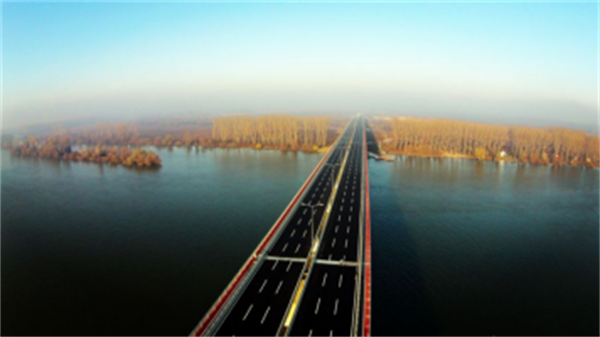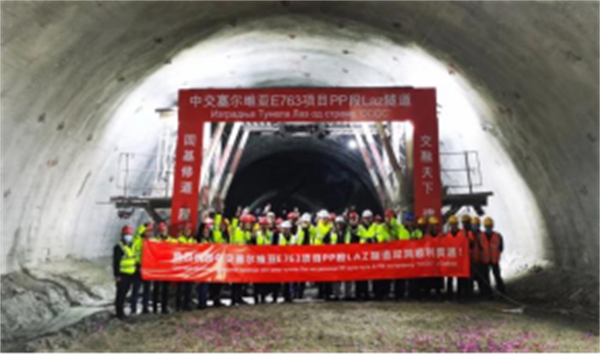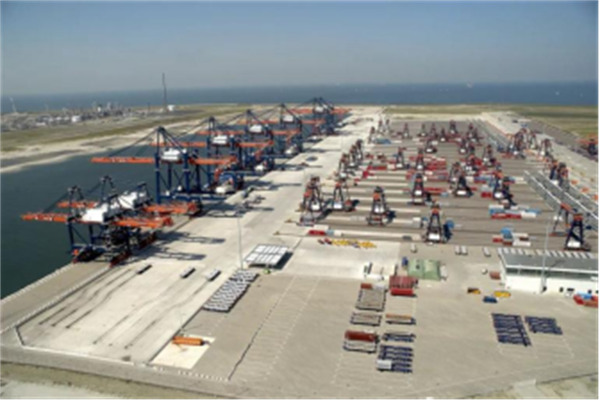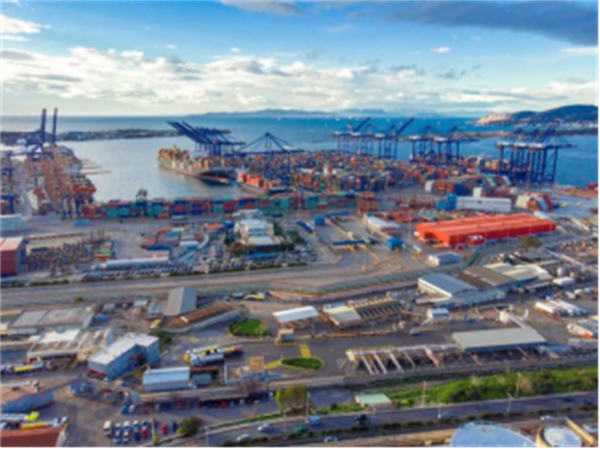From bridges to highways, China Communications Construction Company Limited (CCCC) has played a key role in infrastructure construction in Europe since the Belt and Road Initiative was proposed in 2013, contributing to China-Europe cooperation and regional economic development in Europe.
China-built bridge connects Chinese and European peoples
The Zemun-Borca Bridge in Serbia is the only bridge over the Danube River in Belgrade. It plays a key role in reliving traffic pressure in the city and has shortened commuting time of residents on both sides of the river to 10 minutes.

A view of the Zemun-Borca Bridge in Serbia [Photo provided to sasac.gov.cn]
During construction of the bridge, China Road & Bridge Corporation of CCCC recruited local engineering management and technical talents and offered them special training.
The project brought in 400 Serbian workers each day on average and their peak number reached 700.
The then project manager said that the project was a platform to cultivate construction talents in Serbia and made local people see opportunities created through the Belt and Road cooperation.
Marina, general manager assistant of CCCC’s office in Serbia, was one of the first Serbian workers at the project. She participated in the preparation of the project and was responsible for tax affairs and recruitment.
Marina said that China is her second hometown and expressed her excitement to see CCCC working on a bridge project in Serbia.
She added that the bridge is a symbol of friendship between the two peoples of China and Serbia and opens a new chapter of China-Serbia cooperation.
Stretching across the land of Croatia and the Peljesac Peninsula, the Peljesac Bridge already sees busy traffic even in the wee hours.
The bridge opened to traffic on July 26, 2022. So far, nearly 3 million vehicles have transited it. The bridge has greatly shortened travel time between affected cities and has driven development of the tourism, transportation and logistics industries.

An aerial view of the Peljesac Bridge in Croatia [Photo provided to sasac.gov.cn]
During construction, CCCC cooperated with 18 design consultation companies, 45 engineering companies and 112 equipment and material suppliers of the European Union.
Ambassador of China to Croatia Qi Qianjin said that the project of the Peljesac Bridge realized win-win and co-development of China, Croatia and the EU. It is a model project for future cooperation of the three sides.
The Peljesac Bridge as a bridge of friendship has also contributed to economic development in Croatia.
China-built highway brings opportunity to development
With a designed length of about 180 kilometers, the South-North Expressway in Montenegro connects the Bar Harbor in the south and the border area of Montenegro and Serbia. The priority section, about 41 kilometers, is the most-difficult-to-build part of the project.
Upon operation, it will be a part of the Pan-European highway network and link several European countries, which will push forward overall economic development of Montenegro and its neighboring countries.

An aerial view of the South-North Expressway in Montenegro [Photo provided to sasac.gov.cn]
Some local drivers said that opening of the highway provides safe and convenient traveling for local people as the former mountainous road has taken many lives.
What's more, the highway has driven economic and tourism development in the country.
As of July 2023, there were about 2.2 million vehicles making use of the highway on a daily basis.
The chief executive officer of the highway project said that once fully operational, the South-North Expressway is expected to connect North, Central and South Montenegro, strengthening connectivity between the country and the central regions of Europe and supporting the country's overall economic growth.
The E763 highway project in Serbia, the first of its kind to be contracted by a Chinese enterprise in Europe, is now in full swing.
Connecting Serbia with Montenegro, the 300-kilometer highway is a transport artery linking the Balkan region and countries neighboring Serbia.
The section shouldered by CCCC is planned to be built in four phases.
The Belgrade-Surcin section opened for service this April. Its operation reduces travel time between the capital city Belgrade and large and medium-sized cities in Southwest Serbia to within an hour, benefiting more than 4 million local people.

Workers pose for a picture in the Laz Tunnel of the E763 project in Serbia. [Photo provided to sasac.gov.cn]
China-built ports connect global trades
In 1993, the world's first automated container terminal started operation at the ECT automated port in Rotterdam, Netherlands, marking the debut of first-generation automated terminals.
In 1998, Shanghai Zhenhua Heavy Industry Co Ltd (ZPMC) provided quay bridge equipment to the ECT automated port, which was the beginning of the company's development in the automated port market.
For the past 30 years, ZPMC has offered one-stop automated port solutions to global users, supporting development of the port and shipping industry around the world.
For example, Vado in Italy used to be a key junction along the Maritime Silk Road. However, the Vado Port could no longer meet modern logistics demands given the rapid development of international trade in recent years. Modern equipment was needed in a dire way.
On Dec 12, 2019, the country's first automated container terminal began operation as a huge crane caught and hoisted a container. It was the first newly-built terminal in the country in the past 30 years.

A view of the automated terminal at Vado Port in Italy [Photo provided to sasac.gov.cn]
The terminal has a 720-meter coastline and is capable of handling 860,000 standard containers annually. Even the world's largest carrier can berth there.
The operation of the terminal relies greatly on ZPMC's port crane equipment, which includes four quay cranes, 14 automated rail-mounted gantry cranes and seven sets of equipment for the storage yard, as well as supporting spare parts and maintenance service. The terminal equipment also involved the first electronic control system to serve an automated terminal in Europe.
With a population of only 8,000, Vado obtained nearly 400 jobs thanks to the automated terminal project. The development of the automated Vado Port is of great significance to economic development in North Italy as it is expected to become a window to Central and South Europe and will play a key role in economic trade with African countries.
In addition to focusing on development in the global automated terminal market, ZPMC also promotes Chinese standards to the world.
Taking opportunity of the research and development linked to the fully-automated terminal system, ZPMC signed cooperation agreements with Maersk, a top global shipping company, and with it jointly set standards for the fully-automated terminal, a first for the industry.
The Piraeus Port of Athens in Greece is another destination of ZPMC's machinery.
As a maritime crossroad located in the Eastern Mediterranean Sea, Greece has played a role as the first bridge for commercial and cultural exchange between Europe and Asia.
Located in Southeast Greece, the Piraeus Port of Athens is one of the largest container terminals in the eastern Mediterranean Sea and supports construction of the China-Europe land-Sea Express Line and Belt and Road projects.

A view of the Piraeus Port of Athens, Greece, one of the largest container terminals in the eastern Mediterranean Sea [Photo provided to sasac.gov.cn]
ZPMC's first quay crane equipment was exported to the Piraeus Port in 2010.
Later in 2016, ZPMC provided 19 quay cranes and 16 rail-mounted gantry cranes to the port. The machines are capable of working as far as 72 meters in reach and as high 54 meters or more above the wharf surface.
It's worth noting that the container spreader that operates at the port is able to download 80 tons of goods and is one of the world's largest pieces of quay crane equipment.
In 2021, the port purchased three automated remote control quay cranes, the first of their kind to work at the port, which helped realize operation of the quay crane from the remote-control center, improving the working environment and making on-site work smarter, safer and more efficient.
Cooperation of ZPMC and the port drives development of employment, economy and infrastructure in affected area and has become a model of China-Greece economic and trade cooperation under the framework of the Belt and Road Initiative.
(Executive editor: Xie Yunxiao)